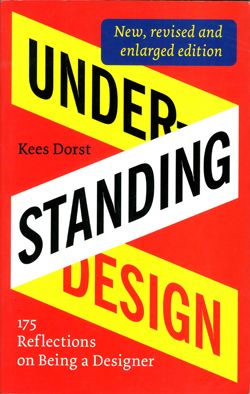Understanding Design
Kees Dorst
Dorst, Kees;
Understanding Design
BIS Publishers 2006 (2003), 239 pages
ISBN 158423265X, 9781584232650
topics: | design | philosophy
Organized as a set of insightful one-page essays. Despite the occasional reference to Heidegger or Foucault, the essays are down-to-earth. Some experiences are specific to design, others may relate not only to design, but to many arenas of expert behaviour.
Martin Siegel on Amazon: "Each essay is to be savored like a fine piece of chocolate."
What is design?
Let's take a group of friends on Saturday night.
Situation 1: They are looking for a good movie in town.
Situation 2: They want to set out and have a party.
1 is problem solving. 2 is design.
Why?
a) S2 has a pivotal concept - what is a party?
b) there is no dominant solution for what a party is
c) S2 requires the use of thought experiments ('Shall
we go to a club?'
d) even the tools for solving the problem have to be
developed - e.g. 'let's vote on this, guys"
[great example, but not completely convincing. but then, such matters
never are.]
[p.45]
Constraint
Closed design problems are more like puzzles. If the jigsaw piece doesn't fit, you imediately know it. Some design problems are much more 'open' - they require considering a wide range of possibilities. You juggle ideas, look at them critically, reconsider repeatedly. You gradually learn more about the problem. There could possibly be two different types of designers. There is creativity and inventiveness involved in both, though designers often don't see it in that way. The 'creatives' who deal more with open problems, tend to look down on the others. The 'closed problem' types often downplay their creative sides. As the industrial designer Richard Stevens observed: "A lot of engineering design is intuitive, based on subjective thinking. But an engineer is unhappy doing this. He wants to test - test and measure. He's been brought up this way and he's unhappy if he can't prove something." p.35
The story
When you design, you are actually creating two things in parallel: the design itself and the story behind it. This story consists of all the choices you have made during your design project and the arguments that you used in making them. It is the justification for the design, which explains [the] why. p.30
Habitualness in Design
What do you experience when you are designing? Most of the time you are within a flow of consciousness, more or less intuitively following patterns of reasoning. It's only when the flow breaks down that you become aware of the wider context around you. It's as if you wake up. Heidegger [talks] of hammering a nail into the wall. You never think about the hammer - you just pick it up and start hammering. It naturally acts as an extension of your body. The only time you think about the hammer is when it breaks. The same is true for design. You are deeply engrossed in exploring a particular path towards a solution, oblivious of anything else. The moment a reasoning track comes to a dead end, you have to step back and choose a new direction. 83
author bio
Professor Kees Dorst - Dutch design scholar, educator, consultant and practitioner - presents 175 provoking essays to stimulate designers to think about what they do, how they do it, why and to what effect. An exploration of design to inspire and give insight. Kees Dorst was trained as an Industrial Design Engineer at the University of Technology in Delft, Holland. He currently is Associate Dean Research and Professor of Design at the University of Technology, Sydney - and Senior Researcher in design at Eindhoven University of Technology. He brought about 50 products to market as a product designer for various design firms. "English editing : Phyllis Crabill"
Send your jottings to Book Excerptise
to contribute some excerpts from your favourite book to
book
excerptise. send us a plain text file with
page-numbered extracts from your favourite book. You can preface your
extracts with a short review.
email to (bookexcerptise [at] gmail [dot] com).
bookexcerptise is maintained by a small group of editors. comments are always welcome at bookexcerptise [at] gmail. This article last updated on : 2014 Feb 07
